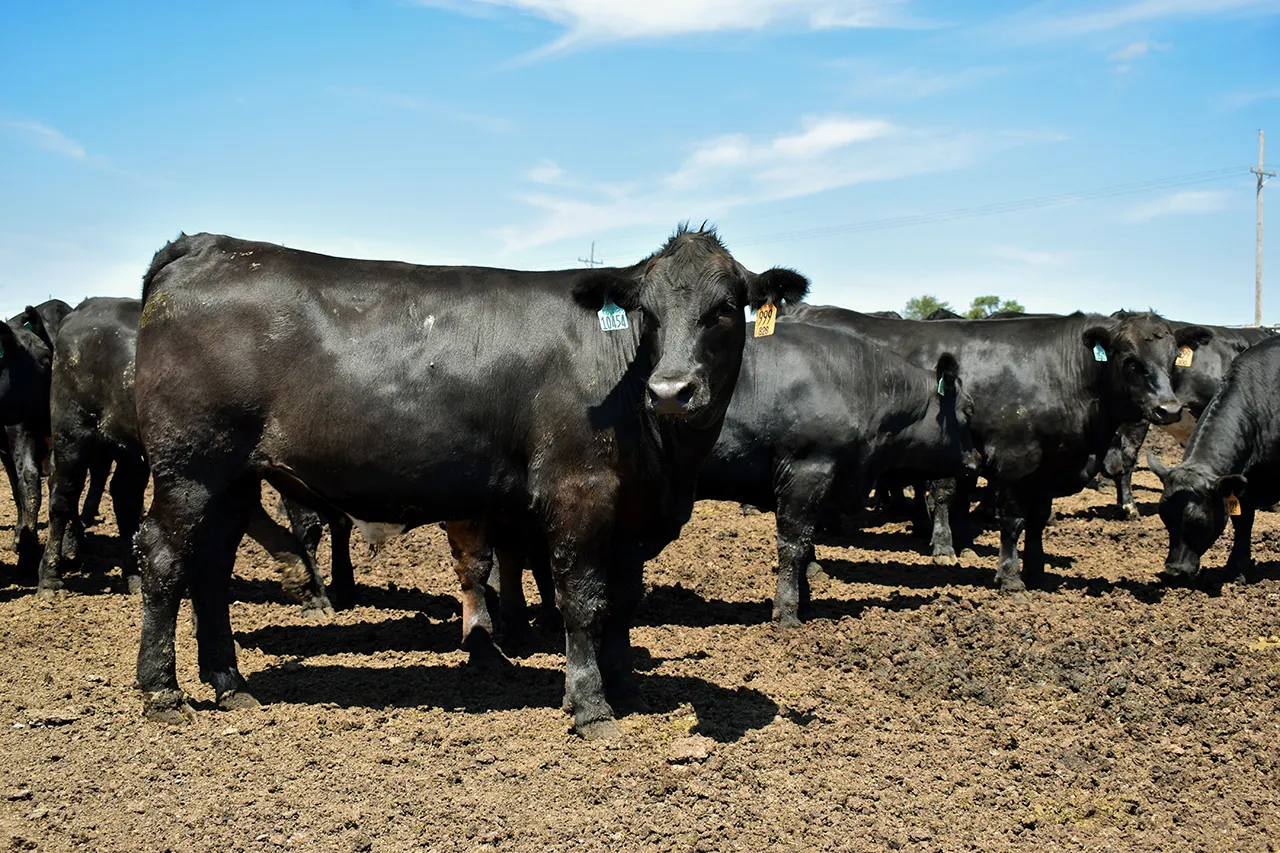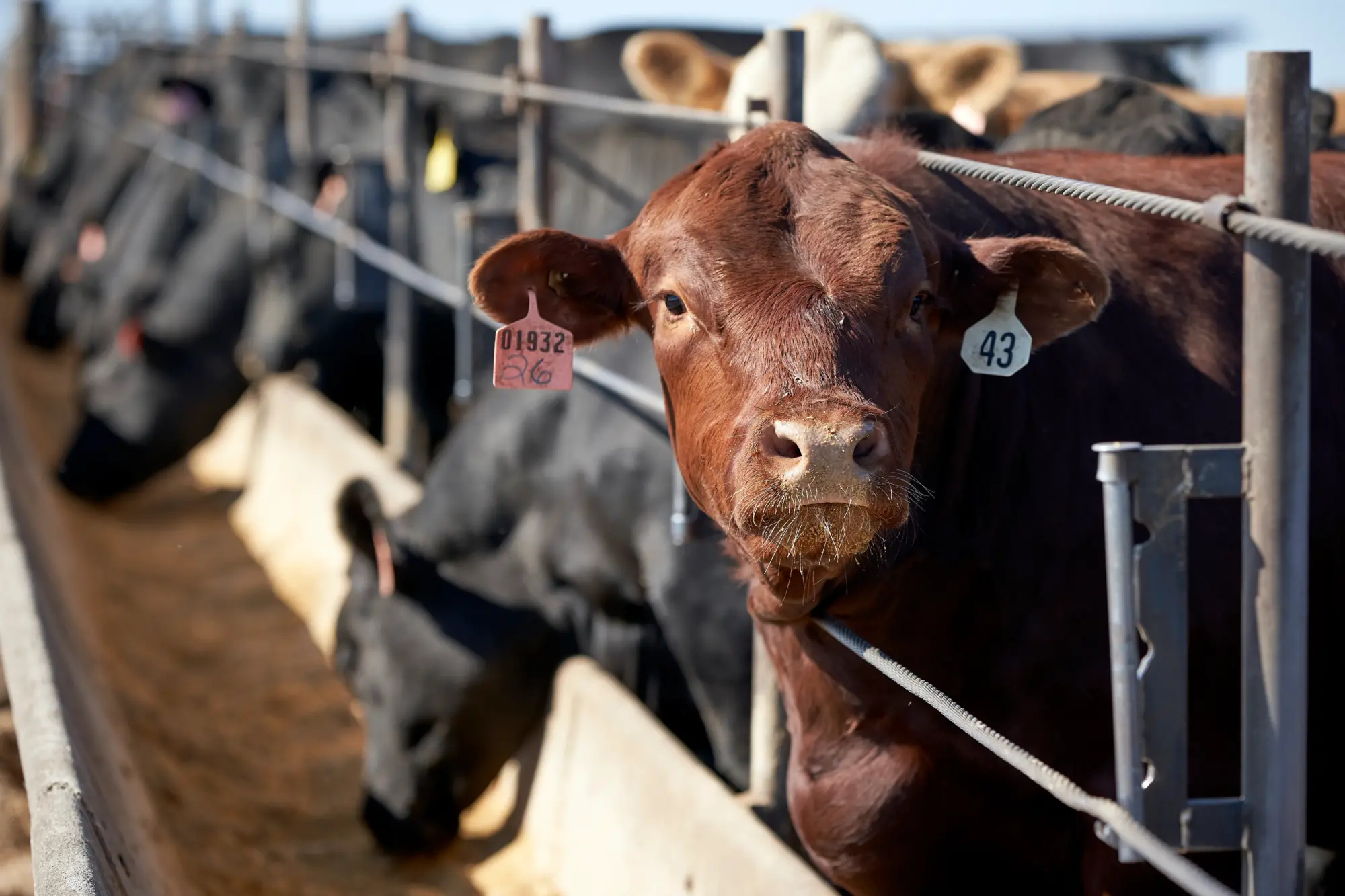Boost your profits with our beef-on-dairy calf finishing guide. Maximize returns and enhance meat quality with essential strategies.
Summary: Did you know the U.S. cattle inventory is the smallest it’s been in 73 years? While consumer demand for beef rises, dairy farmers can tap into this opportunity with beef-on-dairy programs, which now make up about 18-24% of U.S. beef production. Raising these animals right from start to finish is key to achieving quality and profitability. Effective finishing programs, which emphasize health, muscle growth, and proper nutrition, lead to better meat quality, fewer health concerns, and higher economic returns. These calves, which are about $0.15 cheaper per pound than native meat breeds, outperform typical dairy calves by over $200 per head. However, it’s crucial to source well-documented healthy animals, minimize stress, prevent disease spread, develop strong vaccination protocols, balance nutrition, avoid overfeeding, maintain health checks, and prepare facilities properly.
- The U.S. cattle inventory is at its lowest in 73 years, but consumer demand for beef is rising.
- Beef-on-dairy programs account for 18-24% of U.S. beef production, offering significant opportunities for dairy farmers.
- Effective finishing programs that focus on health, muscle growth, and proper nutrition lead to superior meat quality and higher returns.
- Beef-on-dairy calves are about $0.15 per pound cheaper than native meat breeds and offer a financial advantage of over $200 per head compared to typical dairy calves.
- Sourcing healthy animals with accurate health records is crucial for minimizing production costs and maximizing profitability.
- Minimizing stress, preventing disease spread, and implementing strong vaccination protocols are essential for cattle health.
- A balanced nutrition program is vital for optimal growth and meat quality in beef-on-dairy calves.
- Avoiding overfeeding helps maintain a desirable lean-to-fat ratio, essential for quality grading and profitability.
- Proper facility preparation and ongoing health checks are necessary for raising beef-on-dairy calves successfully.

Did you know the US cattle inventory is at its lowest point in 73 years? Meanwhile, consumer demand for beef is rising. This presents an opportunity for novel beef-on-dairy operations. These animals account for 18% to 24% of US beef output. Consider constant marbling, tenderness, and taste, increasing beef supply and quality. Effective finishing programs lead to fewer health concerns, better meat quality, and higher economic returns.
Thinking About Your Bottom Line? Let’s Talk Dollars and Cents
Are you focused on your bottom line? Let’s delve into the financials. One of the most significant advantages of rearing beef-on-dairy calves is the cost savings. These calves are approximately $0.15 cheaper per pound than native meat breeds. While this may not seem substantial initially, the cumulative effect is significant. These savings can substantially boost your profit margins as you build your herd, giving you a reason to be optimistic about the financial future of your business.
Furthermore, beef-on-dairy calves have higher feed efficiency. They convert feed into muscle more efficiently than pure dairy cows, allowing you to produce higher-quality beef with less input. For dairy producers, this is a game changer. Implementing beef-on-dairy initiatives may reduce operating expenses and increase income sources. Studies show that beef-sired calves outperform typical dairy calves by over $200 per head.
Why not seize this opportunity? Combining reduced expenses and improved returns makes beef-on-dairy a financially sound choice. Moreover, given the current market conditions, there has never been a better time to diversify and optimize your cattle business.
Why Sourcing Matters: The Hidden Costs of Unknown Health Histories
Acquiring animals from reputable farms with accurate health records and solid nutritional foundations is not just crucial; it’s a matter of confidence. Why? Because calves with uncertain health and nutrition histories can be a liability. They often lead to higher production costs due to extended feeding periods and medical expenses. Additionally, mixing animals from different locations increases the risk of disease outbreaks. Producers can significantly mitigate these risks by selecting well-documented, healthy animals, leading to a more efficient and productive beef-on-dairy operation.
Stress-Free Cattle: The Cornerstone of Effective Husbandry Practices
Effective animal husbandry procedures are critical for beef-on-dairy calves’ health and performance. Handling measures that reduce stress is not just necessary but a responsibility. Stressed animals are more susceptible to sickness, which may have a detrimental influence on growth and meat quality. Keeping cattle pens filled and with suitable bedding may improve their well-being. Adequate bedding promotes comfort while lowering the risk of injury and illness. Cattle are more likely to flourish when relaxed and stress-free, leading to more significant development, robust immune systems, and higher meat quality.
Implement Strong Vaccination and Treatment Protocols
Assume you’ve invested time, work, and money into growing your beef-on-dairy calves, only to be harmed by avoidable diseases. This is not only inconvenient but also costly. Collaborating closely with a veterinarian is critical to developing and executing an adequate immunization and treatment plan.
Effective vaccination procedures are a proactive way to protect your cattle from respiratory infections and other prevalent ailments. According to animal health specialists, respiratory disorders may derail development rates and increase mortality, resulting in unnecessary expenses [Journal of Dairy Science]. Vet-recommended immunization regimes may decrease these dangers, allowing your calves to attain their maximum potential.
Treatment procedures are equally important. Early diagnosis and treatment of infections may help slow disease spread within your herd and prevent the need for more dramatic, expensive treatments later. Remember: a stitch in time saves nine. Establishing and sticking to solid health procedures can help your beef-on-dairy calves achieve peak health and production.
Nutrition: The Unseen Hero Behind Top-Quality Beef-On-Dairy Calves
When producing the most excellent beef-on-dairy calves, nutrition is more than simply a checkbox—it is the foundation of their growth. A well-balanced feed is essential for maintaining the optimal lean-to-fat ratio and overall cow health. Have you ever wondered how beef-on-dairy calves obtain such excellent marbling in their meat? The key is to follow a dietary plan that boosts their immune system.
High-protein, high-energy diets have been found to provide considerable advantages. The Purina Animal Nutrition Center’s research has shown that these food programs promote outstanding muscle growth and weight increase. However, it is more challenging than simply loading in the protein. Balancing roughages, forages, and grain is critical for intestinal health, preventing acidity, and producing high-quality cattle.
Are you working with a nutritionist to optimize these nutrients in your cattle’s diet? If not, it is worth considering. Concentrating on a complete nutritional strategy provides the conditions for these calves to flourish and, in the long run, give remarkable outcomes to packers and customers alike.
Overfeeding: Why More Isn’t Always Better
Overfeeding beef-on-dairy calves poses several concerns about the quality and profitability of the meat produced. One of the main issues is the buildup of extra fat, which might need extensive cutting during processing. This wastes resources and harms the dressing % and yield grade, crucial indicators influencing beef market value. Calves carrying too much fat may have a poorer yield grade, diminishing total profit margins.
Furthermore, these calves are genetically inclined to a smaller size than native beef cattle, necessitating a more specialized dietary strategy. Overloading them with food to gain weight might backfire, leading the animals to retain extra fat rather than build lean muscle. Prioritizing lean muscle growth over mere weight is critical for effective feeding regimens. Such initiatives improve meat quality, delight packers and customers, and contribute to a higher yield.
Step By Step Guide for Raising Beef-On-Dairy Calves
- Source Reputable Animals: Choose calves from enterprises with proven health records and nutritional backgrounds to avoid unforeseen expenditures.
- Minimize Stress: To keep your cattle stress-free, utilize gentle handling techniques and offer enough bedding and space in enclosures.
- Segregate New Arrivals: Separate calves from various areas to limit the chance of illness transmission.
- Develop Vaccination and Treatment Protocols: Collaborate with a veterinarian to develop efficient health routines that prevent infections, especially respiratory disorders.
- Establish a Balanced Nutrition Program: Consult a nutritionist to create a protein-rich diet suited to the specific needs of beef-on-dairy calves.
- Monitor and Adjust Dietary Intake: To preserve intestinal health and promote optimum muscle growth, check the roughage, forage, and grain balance regularly.
- Avoid Overfeeding: Excess fat might reduce carcass quality. Instead of focusing just on weight growth, prioritize lean muscle development.
- Maintain Consistent Health Checks: Regularly monitor cattle health to detect early difficulties, guaranteeing a smooth route to high-quality beef output.
- Prepare Facilities Properly: Ensure enough ventilation and space in calf facilities, with particular space allowances for various age groups and activities.
Frequently Asked Questions (FAQs)
What are the financial benefits of a beef-on-dairy program?
Beef-on-dairy calves may command higher prices owing to more excellent meat quality and increased feed efficiency. According to industry studies, beef-sired calves may give a financial advantage of more than $200 per head above regular dairy calves.
How do I choose the right calves for my beef-on-dairy program?
There are three basic age categories to select from: milk-fed calves under eight weeks old, weaned calves from 350 to 700 pounds, and feedlot-ready calves weighing more than 700 pounds. Ensure the sources are from respected companies with good health records and nutritional credentials.
What facilities are necessary for raising beef-on-dairy calves?
Adequate ventilation and space are critical. Make precise space allowances for various age groups and activities, emphasizing feeding and resting places. Proper bedding and stress reduction via excellent husbandry procedures are also significant.
How should I feed beef-on-dairy calves for optimal growth?
Nutrition regimens should be designed with the assistance of a nutritionist. Diets high in protein and energy, supplemented with properly managed roughages, forages, and grains, will meet the nutritional requirements of beef-on-dairy calves for maximum growth and muscle development.
What are the risks of overfeeding beef-on-dairy calves?
While striving for a more significant weight might be appealing, overfeeding produces extra fat, which degrades the carcass’ quality. To optimize meat quality and economic returns, prioritize lean muscle increase over weight gain.
How can I prevent disease spread in my cattle population?
Collaborating with a veterinarian while implementing vital immunization and treatment programs is crucial. New arrivals should be divided into groups to reduce the chance of illness transmission, and regular health checks should be conducted to detect problems early.
What are the environmental benefits of a beef-on-dairy program?
Beef-on-dairy initiatives benefit the environment by reducing greenhouse gas emissions. Calves in these systems are often more feed-efficient, requiring fewer resources to produce premium meat.
The Bottom Line
Producing high-quality beef from beef-on-dairy calves is a continuous process that begins at birth and finishes with finishing. A complete plan focusing on health, nutrition, and correct management methods at all stages assures the animals’ well-being and results in high-quality meat that fulfills customer needs while increasing your bottom line. So, are you ready to optimize the earnings on your beef-on-dairy calves?
 Download “The Ultimate Dairy Breeders Guide to Beef on Dairy Integration” Now!
Download “The Ultimate Dairy Breeders Guide to Beef on Dairy Integration” Now!
Are you eager to discover the benefits of integrating beef genetics into your dairy herd? “The Ultimate Dairy Breeders Guide to Beef on Dairy Integration” is your key to enhancing productivity and profitability. This guide is explicitly designed for progressive dairy breeders, from choosing the best beef breeds for dairy integration to advanced genetic selection tips. Get practical management practices to elevate your breeding program. Understand the use of proven beef sires, from selection to offspring performance. Gain actionable insights through expert advice and real-world case studies. Learn about marketing, financial planning, and market assessment to maximize profitability. Dive into the world of beef-on-dairy integration. Leverage the latest genetic tools and technologies to enhance your livestock quality. By the end of this guide, you’ll make informed decisions, boost farm efficiency, and effectively diversify your business. Embark on this journey with us and unlock the full potential of your dairy herd with beef-on-dairy integration. Get Started!















